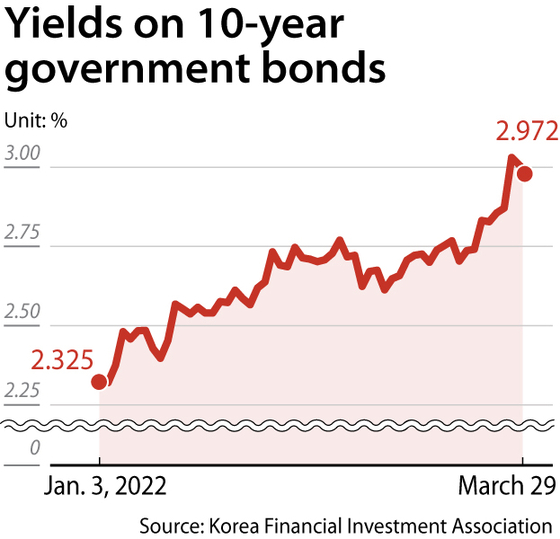Bond yields surge due to Fed, possible supplementary budget

Bond yields are soaring at a rapid pace, driven by the hawkish stance of the U.S. Federal Reserve and the president-elect’s push for a supplementary budget.
The yield on 10-year government bonds crossed the 3-percent mark for the first time in seven and a half years on Monday yielding 3.031 percent, and closed at 2.972 percent on Tuesday.
The yield on 3-year government bonds reached the highest level since June 2014, trading at 2.747 percent Monday, and closed at 2.702 percent on Tuesday.
Meanwhile, the Japanese yen continued to weaken due to the widening gaps between Japanese government bond yields and those of the United States and Korea. The won dropped below 1,000 per 100 yen Monday, the lowest point in more than three years.
On Tuesday, the yen traded at 988.13 won ($0.8) per 100 yen, down by 8.42 won from the day before.
The yield differentials between the Japanese and Korean government bonds led to a weaker yen, because the demand for the Japanese currency dwindled as the yield on its 10-year government bonds remained at the near zero level while Korean and U.S. bond yields went up.
One factor lifting local bond yields is the U.S. Fed’s hawkish monetary policies.
When the U.S. base interest rate, which is currently at 0.5 percent, closes the gap with the Korean base rate (1.25 percent) and brings up the U.S. bond yields, the price of Korean bonds may go down due to a demand decrease. As a result, the yield, which moves inversely to the price, would go up.
Fed Chairman Jerome Powell said on March 21 that U.S. central bank is considering a faster interest rate increase by a half point, or 0.5 percentage points, to curb inflation.
Citigroup forecast that the interest rate may be increased by 2.75 percentage points this year, up by at least 0.5 percentage points in May, June, July and September, according to its Friday report.
The benchmark 10-year government bond traded around 2.46 percent Monday, up about 0.26 percentage points from March 16 when the Federal Open Market Committee (FOMC) held a meeting.
Some analysts expect that the Bank of Korea (BOK) may also jack up the benchmark rate within the second quarter, further pushing up the yields.
“If the Fed ups the base rate in May and June by 0.5 percentage points each, the U.S. base rate would be higher than that of Korea,” said Samsung Securities analyst Kim Ji-man. “Therefore, the BOK may consider an extra increase within the second quarter.”
President-elect Yoon Suk-yeol’s promise to push for a 50-trillion-won supplementary budget is also boosting bond yields.
“It is important to minimize the number of government bonds issued,” said Ahn Cheol-soo, head of the transition team. But the new floor leader of the liberal Democratic Party Park Hong-keun argued that “issuing additional government bonds is unavoidable” in the current economic situation.
Meanwhile, BOK Governor Lee Ju-yeol is set to leave office on March 31.
“We can’t expect the financial authorities to step in to stabilize the market,” said Shin Eol, an SK Securities analyst.
BY AHN HYO-SUNG [shin.hanee@joongang.co.kr]










with the Korea JoongAng Daily
To write comments, please log in to one of the accounts.
Standards Board Policy (0/250자)